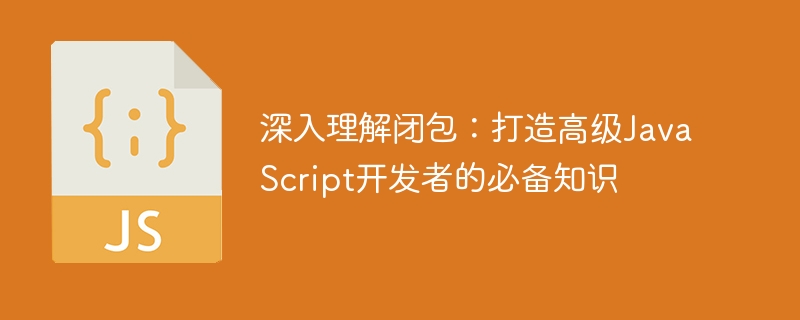

In-depth understanding of closures: essential knowledge to become an advanced JavaScript developer
Introduction: JavaScript, as a dynamic and weakly typed programming language, is in the field of front-end development Plays a pivotal role. Closure is one of the important concepts. Mastering closure technology is crucial to understanding the underlying mechanism of JavaScript and writing high-quality code. This article will deeply analyze the definition, principle and usage scenarios of closures, and give specific code examples, aiming to help developers fully understand closures and use them skillfully in actual projects.
1. Definition and Principle of Closure
Closure (Closure) means that a function can access variables defined outside it. These variables can still be accessed even after the function completes execution. By saving references to external variables, closures allow the life cycle of these external variables to continue without being released and recycled.
In JavaScript, the implementation of closures mainly relies on the features of function nesting and scope chaining. When a function is defined inside another function, the inner function can access the variables and functions of the outer function, forming a closure. After the function is executed, the function execution context is destroyed, but the variables in the closure are still retained in memory for the closure to continue to access.
2. Examples of usage scenarios
function Counter() {
let count = 0;
return {
increment: function() {
count++;
},
decrement: function() {
count--;
},
getCount: function() {
return count;
}
};
}
const counter = Counter();
counter.increment();
console.log(counter.getCount()); // 输出: 1function delayPrint(message, delay) {
setTimeout(function() {
console.log(message);
}, delay);
}
delayPrint('Hello, World!', 1000); // 1秒后输出: Hello, World!function memoize(func) {
const cache = {};
return function(...args) {
const key = JSON.stringify(args);
if (cache[key]) {
return cache[key];
} else {
const result = func.apply(this, args);
cache[key] = result;
return result;
}
};
}
const fibonacci = memoize(function(n) {
if (n === 0 || n === 1) {
return n;
} else {
return fibonacci(n - 1) + fibonacci(n - 2);
}
});
console.log(fibonacci(10)); // 输出:55const module = (function() {
let privateVar = 'I am private';
const privateMethod = function() {
console.log(privateVar);
};
return {
publicMethod: function() {
privateMethod();
}
};
})();
module.publicMethod(); // 输出: 'I am private'3. Summary
As an important concept in JavaScript, closure is crucial for writing advanced and maintainable code. This article starts from the definition, principle and usage scenarios of closures, and gives specific code examples.
With an in-depth understanding of closures, developers can use closures more flexibly in daily JavaScript development to achieve various wonderful functions. When writing high-quality code, proper use of closures can improve code readability, maintainability, and performance.
Therefore, as a senior JavaScript developer, mastering closure technology is essential. I hope this article will be helpful to readers in understanding the concept and essence of closures and mastering how to use closures.
The above is the detailed content of Master closures in depth: an indispensable skill to become an advanced JavaScript developer. For more information, please follow other related articles on the PHP Chinese website!




